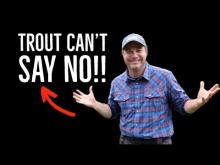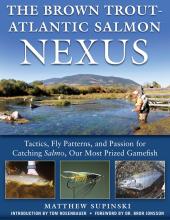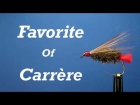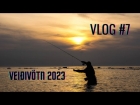Book review: Big Trout - How and Where to Target Trophies
If you're content fishing for ten inch brown trout in secluded settings, great. If you have the desire and means to chase down big (and I mean big) trout, read this book.
I can't imagine a book such as this being written fifty years ago. Can you? A book that not only tells you how to catch big trout, but where and when to go get them? C'mon. A half a century ago, a writer would be banished from angling for letting loose these ideas over drinks at a local watering hole, to say nothing of publishing an entire book.
This really is the Golden Age of Fly Fishing.
First things first - what is a big trout? To Mr. Taylor, a big trout is a brown or rainbow over eight pounds, a cutthroat over five, and a brook trout over four.
Gulp.
Yup. Big trout. And this is the minimum size requirements.
Lots of advice has been given about hunting big fish, but most of it boils down to "fish at night, swing a big black bushy thing across the current, and hang on". I'm sure such advice is well meant, and will probably nab you a good trout on your home waters, but that is not at all what Mr. Taylor is talking about. He goes way beyond that.
He jumps off by describing the types of environments that will product big trout. The kind of waters - stillwaters, tailwaters, migratory rivers, the forage base and biomass productivity (big trout need lots of things to eat, and the things they eat also need lots of things to eat, etc.), and even the genetic traits of fish that produce large specimens. While he does offer some specific bodies of water as evidence, the point of this chapter is not to stick pins in a map and give you directions to the "hog hole", but rather to describe big trout habitat.
He goes on to talk about the behavior of the fish - how they feed, when they are active, and where they may be found in a body of water.
If you were to skip all that and jump to the chapter that lists rivers and lakes, and when to fish them, you'd be doing yourself a disservice. I found his discussion on contrast in flies excellent, as I've had the firm believe that the effectiveness of a fly such as a Black Ghost can be mostly attributed to the broad silver tinsel wrapped in a wide spiral along a black floss body. Such a contrast will catch a trout's eye - a theory supported by Mr. Taylor.
It's also interesting to learn how a big trout will attack their prey. He sheds a little light on the mystery of the "short strike". As a long time streamer fisherman, I've had my share of short strikes and I found the discussion fascinating. While I may not have the opportunity to fish on waters known for Big Trout according to Mr. Taylor's view, the ideas are certainly not limited to these waters. We all can benefit.
The discussion of how fish locate their prey is equally fascinating. Many of us have been told that flies such as muddlers and bushy wooly buggers are effective in low visibility conditions because they emit vibrations that the trout "hear". Mr. Taylor expands on that to teach us that a trout's hearing can also be a disadvantage to anglers, as some sounds will cause alarm. In both flies and angler behavior, Mr. Taylor gives us some ideas to prevent alarming fish, while attracting them to our flies.
Fly tyers will also enjoy this book as they are some new patterns and different thoughts on fly design, such as how to create contrast in a fly when viewed from different angles. The "Stinging Sculpin" appears to be a simple and effective fly that I just may have to give a try in my own local waters. The color patterns and designs of his "Stinging Hair" also need some local trials.
On and on. This book is chock full of great information. Yes - there is a chapter listing rivers and lakes and when to fish them. That is great information for those of us who haven't a clue where to find an eight pound rainbow trout, but the essence of the book is the discussion of the biology of these trout and the methods used to fish for them effectively. This information is applicable to all of our fishing.
Lastly, I'd be remiss if I did not mention the photos. Black and white pictures of anglers holding the biggest trout I've ever seen. Yeah - really BIG trout. The picture of the mounted trout taken from the Frying Pan River - someone found it dead - is amazing. The fish is almost square, it's so big. Crazy.
A good book, filled with practical information gathered from years of research and discussions with fellow anglers. If you want to know more about trout, this is a terrific resource.
Read more about why you should register.
More content from the front page
Since you got this far …
… I have a small favor to ask.
Long story short
Support the Global FlyFisher through several different channels, including PayPal.
Long story longer
The Global FlyFisher has been online since the mid-90's and has been free to access for everybody since day one – and will stay free for as long as I run it.
But that doesn't mean that it's free to run.
It costs money to drive a large site like this.
See more details about what you can do to help in this blog post.

























































Comments
Hey I just caught my
Hey I just caught my first 8.8lb rainbow trout from jericho loch in dumfries I caught it using floating ling with 6lb leader and a small red and white fritz I'm just a beginner and I'm certainly hooked there was a few fishers on the water that came to see the fish and congratulated me I went on and caught 3 more that were considerably smaller but I got my big fish so I was over the moon the other fishers were saying the fishing was very slow and I just had beginners luck I just hope I can go back a land a 10lber plus lol my names going to appear in the Sept/oct edition of trout fisherman so as you can imagine I'm extremely happy if anyone has any tips or know what flies catch big fish cld u pls let me know thaks from Charlie gallagher in dumfries.